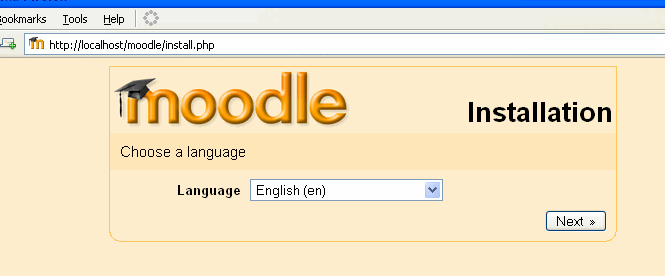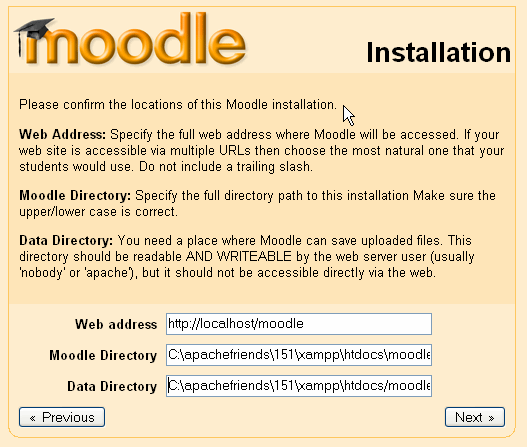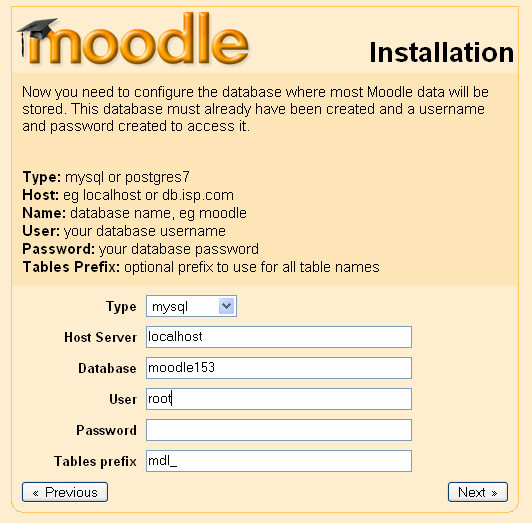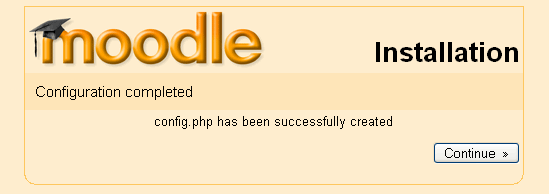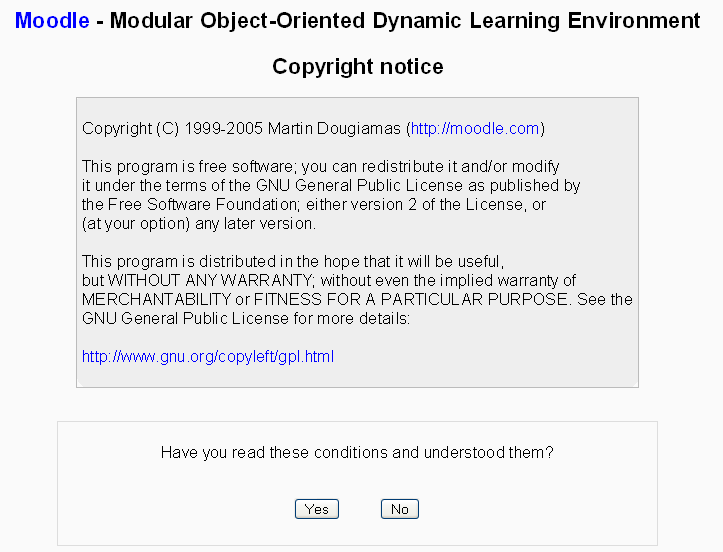Windows installation using XAMPP: Difference between revisions
From MoodleDocs
Ray Lawrence (talk | contribs) |
Ray Lawrence (talk | contribs) mNo edit summary |
||
| Line 2: | Line 2: | ||
== Windows installation using XAMP == | == Windows installation using XAMP == | ||
XAMPP is a package which installs PHP, Apache and MySql (amongst other things) and will enable you to run Moodle on a Windows PC, Laptop or Server. | *XAMPP is a package which installs PHP, Apache and MySql (amongst other things) and will enable you to run Moodle on a Windows PC, Laptop or Server. | ||
The following is a step by step guide to installing Moodle on a computer running Windows XP using the XAMPP package. | *The following is a step by step guide to installing Moodle on a computer running Windows XP using the XAMPP package. | ||
===Preparation=== | ===Preparation=== | ||
| Line 10: | Line 10: | ||
====Get Moodle!==== | ====Get Moodle!==== | ||
Download the version of Moodle you wish to install from [http://download.moodle.org/ Moodle.org] | *Download the version of Moodle you wish to install from [http://download.moodle.org/ *Moodle.org] | ||
[[Image: 14a.gif]]. | [[Image: 14a.gif]]. | ||
| Line 16: | Line 16: | ||
====Get XAMPP!==== | ====Get XAMPP!==== | ||
Download XAMPP for Windows from [http://www.apachefriends.org/en/xampp.html Apachefrienrds.org]. This example assumes that you have downloaded the “Installer” package. | *Download XAMPP for Windows from [http://www.apachefriends.org/en/xampp.html Apachefrienrds.org]. This example assumes that you have downloaded the “Installer” package. | ||
[[image:Xampp1.png]] | [[image:Xampp1.png]] | ||
====Allow yourself some time==== | ====Allow yourself some time==== | ||
Say 45 minutes. | *Say 45 minutes. | ||
===Installing XAMPP=== | ===Installing XAMPP=== | ||
Run the installer, eventually you will be presented with an option about where to install the package. | *Run the installer, eventually you will be presented with an option about where to install the package. | ||
[[image:Xampp2.gif]] | [[image:Xampp2.gif]] | ||
In this example we are installing the package at c:\apachefriends\151 – that’s because it suits what our needs, you can choose you own location. | *In this example we are installing the package at c:\apachefriends\151 – that’s because it suits what our needs, you can choose you own location. | ||
Continue with the installation, this will take a while! | *Continue with the installation, this will take a while! | ||
[[image:Xampp3.gif]] | [[image:Xampp3.gif]] | ||
Eventually you will be presented with the option to install Apache, MySQL, Filezilla as a service. | *Eventually you will be presented with the option to install Apache, MySQL, Filezilla as a service. | ||
[[image:Xampp4.gif]] | [[image:Xampp4.gif]] | ||
It’s probably best to choose “No” for now. You can always enable these as services later. | *It’s probably best to choose “No” for now. You can always enable these as services later. | ||
Next you’ll be asked if you want to start the XAMPP Control Panel. | *Next you’ll be asked if you want to start the XAMPP Control Panel. | ||
[[image:Xampp5.gif]] | [[image:Xampp5.gif]] | ||
Click the “No” button. | *Click the “No” button. | ||
===Change PHP version=== | ===Change PHP version=== | ||
It’s a good idea to switch to PHP version 4.x before installing Moodle. Roll back to an earlier version of PHP as follows: | *It’s a good idea to switch to PHP version 4.x before installing Moodle. Roll back to an earlier version of PHP as follows: | ||
From the “Start” menu locate the program group for apachefriends > xampp | *From the “Start” menu locate the program group for apachefriends > xampp | ||
[[image:Xampp20.gif]] | [[image:Xampp20.gif]] | ||
Select “php switch” | *Select “php switch” | ||
[[image:Xampp21.gif]] | [[image:Xampp21.gif]] | ||
Follow the instructions in the window. | *Follow the instructions in the window. | ||
[[image:Xampp22.gif]] | [[image:Xampp22.gif]] | ||
| Line 65: | Line 65: | ||
===Launch XAMPP Control Panel === | ===Launch XAMPP Control Panel === | ||
On your Desktop, locate the XAMPP icon and double click to launch the Control Panel. | *On your Desktop, locate the XAMPP icon and double click to launch the Control Panel. | ||
When the XAMPP Control Panel has launched, click the “Start” buttons for Apache and MySQL. | *When the XAMPP Control Panel has launched, click the “Start” buttons for Apache and MySQL. | ||
[[image:Xampp6.gif]] | [[image:Xampp6.gif]] | ||
If all is well you will see something like this. | *If all is well you will see something like this. | ||
[[image:Xampp31.gif]] | [[image:Xampp31.gif]] | ||
| Line 77: | Line 77: | ||
===Create the database=== | ===Create the database=== | ||
To create a database for your Moodle “site” we will use the phpMyAdmin utility included with XAMPP. | *To create a database for your Moodle “site” we will use the phpMyAdmin utility included with XAMPP. | ||
To access this launch the web browser of your choice (Firefox is used in this example), type http://localhost in the address bar. | *To access this launch the web browser of your choice (Firefox is used in this example), type http://localhost in the address bar. | ||
[[image:Xampp8.gif]] | [[image:Xampp8.gif]] | ||
The XAMPP default page is displayed, click the link for your preferred language – we will be using English. | *The XAMPP default page is displayed, click the link for your preferred language – we will be using English. | ||
[[image:Xampp9.gif]] | [[image:Xampp9.gif]] | ||
From the menu on the left, click on “phpMyAdmin” | *From the menu on the left, click on “phpMyAdmin” | ||
[[image:Xampp10.gif]] | [[image:Xampp10.gif]] | ||
When phpMy Admin has launched in your browser window, enter the name of your database in the “Create new database” field. In this example we are naming our database “moodle153”. | *When phpMy Admin has launched in your browser window, enter the name of your database in the “Create new database” field. In this example we are naming our database “moodle153”. | ||
[[image:Xampp11.gif]] | [[image:Xampp11.gif]] | ||
Click the “Create” button to create the database. | *Click the “Create” button to create the database. | ||
[[image:Xampp12.gif]] | [[image:Xampp12.gif]] | ||
| Line 105: | Line 105: | ||
===Extract the downloaded Moodle files to the correct location.=== | ===Extract the downloaded Moodle files to the correct location.=== | ||
Locate the file downloaded from Moodle.org and either copy or cut the file to the Windows clipboard. | *Locate the file downloaded from Moodle.org and either copy or cut the file to the Windows clipboard. | ||
Open the XAMPP Control Panel and click on the “Explore” button. | *Open the XAMPP Control Panel and click on the “Explore” button. | ||
[[image:Xampp15.gif]] | [[image:Xampp15.gif]] | ||
A Windows Explorer view similar to the one below will be displayed. | *A Windows Explorer view similar to the one below will be displayed. | ||
[[image:Xampp16.gif]] | [[image:Xampp16.gif]] | ||
Open the “htdocs” folder. | *Open the “htdocs” folder. | ||
[[image:Xampp17.gif]] | [[image:Xampp17.gif]] | ||
| Line 121: | Line 121: | ||
[[image:Xampp18.gif]] | [[image:Xampp18.gif]] | ||
Paste the file cut/copied earlier into this folder. | *Paste the file cut/copied earlier into this folder. | ||
Extract the Moodle files from the file downloaded earlier. A default folder named “moodle” is created with the Moodle files within. | *Extract the Moodle files from the file downloaded earlier. A default folder named “moodle” is created with the Moodle files within. | ||
[[image:Xampp19.gif]] | [[image:Xampp19.gif]] | ||
| Line 129: | Line 129: | ||
===Start the installation=== | ===Start the installation=== | ||
In your web browser, type the path to the folder containing the Moodle files in te address bar – in this example it’s <nowiki>http://localhost/moodle</nowiki>. | *In your web browser, type the path to the folder containing the Moodle files in te address bar – in this example it’s <nowiki>http://localhost/moodle</nowiki>. | ||
[[image:Xampp23.gif]] | [[image:Xampp23.gif]] | ||
The initial install page is displayed. | *The initial install page is displayed. | ||
[[image:Xampp24.gif]] | [[image:Xampp24.gif]] | ||
Choose your preferred language (English is used in this example) and click the “Next” button. | *Choose your preferred language (English is used in this example) and click the “Next” button. | ||
A diagnostic report is displayed – hopefully it will look like this, if not you may need to address some issues. | *A diagnostic report is displayed – hopefully it will look like this, if not you may need to address some issues. | ||
[[image:Xampp25.gif]] | [[image:Xampp25.gif]] | ||
Click the “Next” button to continue. | *Click the “Next” button to continue. | ||
The paths for your Moodle installation are shown – accept these or amend as desired. | *The paths for your Moodle installation are shown – accept these or amend as desired. | ||
[[image:Xampp26.gif]] | [[image:Xampp26.gif]] | ||
Click the “Next” button to continue | *Click the “Next” button to continue. | ||
*In this screen we enter the database settings. The fields are populated with some suggested values. | |||
[[image:Xampp27.gif]] | [[image:Xampp27.gif]] | ||
In this example the database created is “moodle153”. The “root” user will be used without a password. | *In this example the database created is “moodle153”. The “root” user will be used without a password. | ||
DO NOT USE THE “ROOT” USER WITHOUT A PASSWORD FOR PRODUCTION INSTALLATIONS AS THIS | *DO NOT USE THE “ROOT” USER WITHOUT A PASSWORD FOR PRODUCTION INSTALLATIONS AS THIS CREATES A SECURTIY VULNERABILITY | ||
[[image:Xampp28.gif]] | [[image:Xampp28.gif]] | ||
When the fields have been populated, click the “Next” button to continue. | *When the fields have been populated, click the “Next” button to continue. | ||
Provided the Moodle folder is writable a message confirming the configuration has been completed will be displayed. | *Provided the Moodle folder is writable a message confirming the configuration has been completed will be displayed. | ||
[[image:Xampp29.gif]] | [[image:Xampp29.gif]] | ||
Click the “ Continue” button to proceed. | *Click the “ Continue” button to proceed. | ||
The Moodle copyright / licence notices are displayed. | The Moodle copyright / licence notices are displayed. | ||
| Line 174: | Line 173: | ||
[[image:Xampp30.gif]] | [[image:Xampp30.gif]] | ||
Click the “Yes” button to continue, then follow the instructions on the following screens. | *Click the “Yes” button to continue, then follow the instructions on the following screens. | ||
===Troubleshooting=== | ===Troubleshooting=== | ||
====Skype==== | ====Skype==== | ||
If XAMPP does not work when you launch your browser and you have [http://www.skype.com Skype] enabled it may be necessary to change the port settings in Skype. | *If XAMPP does not work when you launch your browser and you have [http://www.skype.com Skype] enabled it may be necessary to change the port settings in Skype. | ||
* Locate "Options..." in Skype. | * Locate "Options..." in Skype. | ||
Revision as of 21:28, 8 February 2006
- Return to Windows installation
Windows installation using XAMP
- XAMPP is a package which installs PHP, Apache and MySql (amongst other things) and will enable you to run Moodle on a Windows PC, Laptop or Server.
- The following is a step by step guide to installing Moodle on a computer running Windows XP using the XAMPP package.
Preparation
Get Moodle!
- Download the version of Moodle you wish to install from *Moodle.org
Get XAMPP!
- Download XAMPP for Windows from Apachefrienrds.org. This example assumes that you have downloaded the “Installer” package.
Allow yourself some time
- Say 45 minutes.
Installing XAMPP
- Run the installer, eventually you will be presented with an option about where to install the package.
- In this example we are installing the package at c:\apachefriends\151 – that’s because it suits what our needs, you can choose you own location.
- Continue with the installation, this will take a while!
- Eventually you will be presented with the option to install Apache, MySQL, Filezilla as a service.
- It’s probably best to choose “No” for now. You can always enable these as services later.
- Next you’ll be asked if you want to start the XAMPP Control Panel.
- Click the “No” button.
Change PHP version
- It’s a good idea to switch to PHP version 4.x before installing Moodle. Roll back to an earlier version of PHP as follows:
- From the “Start” menu locate the program group for apachefriends > xampp
- Select “php switch”
- Follow the instructions in the window.
Launch XAMPP Control Panel
- On your Desktop, locate the XAMPP icon and double click to launch the Control Panel.
- When the XAMPP Control Panel has launched, click the “Start” buttons for Apache and MySQL.
- If all is well you will see something like this.
Create the database
- To create a database for your Moodle “site” we will use the phpMyAdmin utility included with XAMPP.
- To access this launch the web browser of your choice (Firefox is used in this example), type http://localhost in the address bar.
- The XAMPP default page is displayed, click the link for your preferred language – we will be using English.
- From the menu on the left, click on “phpMyAdmin”
- When phpMy Admin has launched in your browser window, enter the name of your database in the “Create new database” field. In this example we are naming our database “moodle153”.
- Click the “Create” button to create the database.
The new database should be present in the dropdown list when the page has refreshed.
Extract the downloaded Moodle files to the correct location.
- Locate the file downloaded from Moodle.org and either copy or cut the file to the Windows clipboard.
- Open the XAMPP Control Panel and click on the “Explore” button.
- A Windows Explorer view similar to the one below will be displayed.
- Open the “htdocs” folder.
- Paste the file cut/copied earlier into this folder.
- Extract the Moodle files from the file downloaded earlier. A default folder named “moodle” is created with the Moodle files within.
Start the installation
- In your web browser, type the path to the folder containing the Moodle files in te address bar – in this example it’s http://localhost/moodle.
- The initial install page is displayed.
- Choose your preferred language (English is used in this example) and click the “Next” button.
- A diagnostic report is displayed – hopefully it will look like this, if not you may need to address some issues.
- Click the “Next” button to continue.
- The paths for your Moodle installation are shown – accept these or amend as desired.
- Click the “Next” button to continue.
- In this screen we enter the database settings. The fields are populated with some suggested values.
- In this example the database created is “moodle153”. The “root” user will be used without a password.
- DO NOT USE THE “ROOT” USER WITHOUT A PASSWORD FOR PRODUCTION INSTALLATIONS AS THIS CREATES A SECURTIY VULNERABILITY
- When the fields have been populated, click the “Next” button to continue.
- Provided the Moodle folder is writable a message confirming the configuration has been completed will be displayed.
- Click the “ Continue” button to proceed.
The Moodle copyright / licence notices are displayed.
- Click the “Yes” button to continue, then follow the instructions on the following screens.
Troubleshooting
Skype
- If XAMPP does not work when you launch your browser and you have Skype enabled it may be necessary to change the port settings in Skype.
- Locate "Options..." in Skype.
- Locate the "Connection" options.
- Remove the tick / check from the Checkbox.
- Click the "Save" button.
- You may need to re-start your computer for this to take effect.


